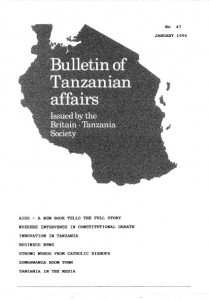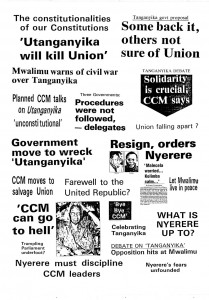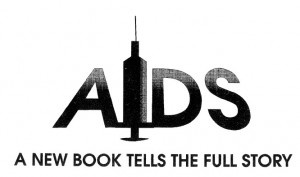ADJUSTMENT IN AFRICA: REFORMS, RESULTS AND THE ROAD AHEAD.
Part of a Series of World Bank Research Reports. Oxford University Press. 1994
This recently published report has put Tanzania among the best performing adjusting economies in sub-Saharan Africa. Of the 26 countries which the study ranked by macroeconomic policy performance, Tanzania was among the six which had shown a significant improvement in policies. The others are Ghana, the Gambia, Burkina Faso, Nigeria and Zimbabwe. These countries also had the largest improvement in per capita GDP growth. The study points out that countries which suffered a deterioration in macroeconomic policies also had the poorest growth record.
The report, which is designed to lead to a better understanding of the relationship between policies and growth in Africa, found that the extent of policy reform varied widely. On the whole, countries did better in improving macroeconomic than financial sector reform or the reform of public enterprises. Almost two-thirds of countries managed to improve their macroeconomic policies between the beginning and end of the 1980’s. The economies that have liberalised their pricing and marketing of agriculture and, in general reduced taxation and discrimination against agriculture (Tanzania is one of these) have experienced a resurgence in domestic production of both food and export crops. The adoption of more realistic exchange rates has also helped to provide incentives for domestic activities and discouraged excessive dependence on imported goods. The study also demonstrates that devaluation does not necessarily result in higher rates of inflation where correct measures accompany such devaluation. The countries which followed devaluation with complementing policies of wage, fiscal and monetary restraint did not experience inflationary pressures. Tanzania, for example, has managed to reduce its inflation from over 40% in the mid- 1980’s to just over 20% currently. This is a significant achievement but is still far below what is expected of those economies which are performing well.
The study shows that where policies have improved, renewed economic growth has taken place. In particular, improvements in exchange rate policies were strongly associated with faster growth. It points cut that 14 countries have shown improvement in macroeconomic policies and a positive change in per capita income growth rates. The six countries that improved their policies the most (Tanzania included) had the biggest improvements in the rate of GDP growth per capita – an increase of about two percentage points per annum in the period 1081-86 and 1987-91. During the same period, countries which did not improve their policies experienced falls in per capita growth rates of over two percentage points per annum.
One of the main conclusions of the study is the responsiveness of exports to policy reform; despite declining terms of trade, the study indicates that there has been a substantial increase in export volumes in most adjusting economies that have combined exchange rate and agriculture price and marketing liberalisation policies.
Although the study paints the picture that sub-Saharan Africa’s economic decline may have been arrested, and in most cases modestly reversed, the performance of the many adjusting economies still poses cause for concern. Apart from the fragile social and political environment which is likely to adversely affect the sustainability of the adjustment process in the long term, current growth rates among the best performers are ‘still too low to reduce poverty much in the next two to three decades1. Also, although inflation rates have generally declined, they are still by far too high compared with the best performing economies in other regions of the world. There is an urgent need to implement policies that consistently bear down on inflation and to bring it to single figures, if sustainable growth is to be maintained.
The report indicates that, with today’s policies it will take 40 years before sub-Saharan Africa returns to its income per capita in the mid-1970’s. This is a very bleak scenario indeed.
For Tanzania, which embarked on the adjustment process in 1986, after the failure of the socialist policies enshrined in the Arusha Declaration, the task which lies ahead is formidable. Many low-income earners have suffered from the escalating prices which have accompanied the price and exchange liberalisation. For long-term benefits to be derived, it will be necessary for the government to press ahead with the policy reforms and, in particular, keep on board the IMF and the World Bank. Recent slippage in policy reform and the criticisms that have been expressed by the IMF and some donors, is a matter of serious concern for the future sustainabilty of Tanzania’s reform programme.
E J Kisanga
THE UKIMWI ROAD: FROM KENYA TO ZIMBABWE. Dervla Murphy. John Murray Publishers. 1993. 265 pages. £16.99.
Imagine pedalling 3,000 miles on a bicycle, alone up and down the hills and across the savannah from Kenya through Uganda, Tanzania, Malawi, Zambia and Zimbabwe. Add that you are a sixty-year-old Irish woman who never visited the area before. Then enjoy the fresh, perceptive and sensitive impressions of travel writer Dervla Murphy, and her vivid descriptions of the countryside – lush, barren or drenched with torrential rains. Query her judgements.
Murphy intersperses her travel tales with vignettes of history and conversations with local residents at village hotels and bars where she ends the day. In Bukoba, for example, the costly Tanzanian war with Uganda comes to life as the author ponders relationships between socialism, selfreliance, personal reserve and ‘economic disaster’.
The narrative returns time and again to ‘ukimwi’ the slim disease – AIDS. The author faithfully reports a diversity of beliefs about its causes – Europeans, women, witchcraft? She admires people like Janet, whom she met in Mbeya, as the source of hope: ,Those exceptional African women whose response to AIDS is imaginative and courageous, who know that their feminist hour has comer.
Criticism is apportioned equitably. At one moment the blame for conditions of poverty is put on colonialists, at another on the independent government and yet another on the International Monetary Fund. ‘Malfunctioning western imports’ such as phones that don’t work, banks that have no currency left, schools without textbooks and hospitals without medicines are despised, as are ‘hundreds of vehicles carrying one or two expatriates’ that ‘zoom around rural areas’ (197). She hears educated Tanzanians questioning the appropriateness of a current western import: multi-party democracy. African governments fail to put priority on food production over the cash crops grown by western consortia, she says, because they ‘seem befuddled by the miasma rising from the swamp of IMF and World Bank calculations and arguments (175). Yet, ‘parallel to this world of pretence, the ordinary people survive somehow (183).
Murphy’s conclusion is devastating: that the west ought to ‘quit Africa’ (263). She partly explains that abrupt proposal by saying ‘we still treat Africa as our forebears did in the 1890rs, operating behind a different screen with the same (or worse) greed’. The donors1 approach, she says, ‘denies African civilisation its own dignity and integrity’.
In that scenario of abandonment by the West, MS Murphy, what shall Africa do about an international debt that in 1992 equalled 93% of its GDP – a debt that was accrued by leaders, many now displaced or dead? Do you really think it possible –
or desirable – today to insulate Africa and the West from one another environmentally or economically? Might another scenario be envisioned, with justice and respect on both sides?
Margaret Snyder
GUIDE TO ZANZIBAR AND PEMBA. D Else. Bradt Publications, 1993
164 pages. £8.95.
The Daily Telegraph (February 19th 1994) wrote about this book ‘The publication coincides with a more welcoming approach to visitors to this island off the coast of Tanzania’. It is, of course, more than one island – the book mentions the two largest, Unguja and Pemba and several smaller ones. The Telegraph goes on to write that ‘the Pemba Channel offers perhaps the finest deep-sea fishing along the whole East African coast’. As in the case of the parallel book ‘A Guide to Tanzania’ by the same publishers, which was reviewed in Bulletin No 47, this is an eminently practical, up-to date, ‘how-to’ guide which is surely essential reading for visitors to what it describes as this ‘unspoilt’ place. Zanzibar is described as a good example of tourism as it should be – low-key, not too obtrusive and providing some benefits for the local people without destroying their culture or environment. Visitors are advised to see the island as a community and not as a theme park – DRB.
NEWS FROM MASASI. J Russell and N C Pollock.
Veroffentlichungen der Institute fur Afrikanistik und Agyptologie der Universitat, Vienna. 1993. l60 pages. A few copies are available from Joan Russell, 18 West Bank, York Y02 4ES at £10.20 (including p&p).
At first sight the proposition in the title of this book may appear to be misplaced but the reader soon realises that it has been chosen deliberately. The preface tells us that the motivation for writing it came from twenty-one letters written at the end of the nineteenth and the beginning of the twentieth centuries by an African woman living near Masasi. ‘They are one of the earliest surviving bodies of prose texts written in Swahili, in the roman script, by a woman’. Extracts from them (with English translations) are quoted extensively and illustrate how ordinary people in that part of Africa reacted to some of the outside influences affecting them at the turn of the century.
Ajanjeuli was born into a pagan family in 1883 and baptised Agnes in 1897. She was an intelligent and observant girl who came in contact with Anglican missionaries and through them with the congregation of St. Agnes’ Church, Kensington Park. London, who were the recipients of her letters. The correspondence continued over several years: the earliest one quoted is dated October 1898 and the latest September 1912. Fortunately they have been preserved in the archives of the United Society for the Propagation of the Gospel, and fortunately too they came to the notice of Russell and Pollock. Agnes grew up to be one of the first teachers in what would now be called a village primary school. She married another teacher, Francis Sapuli, who later became an Anglican priest and a highly respected canon of Masasi cathedral. Agnes died shortly before the end of World War I in 1918.
The book has not been written for specialists in any particular branch of learning, although the authors do express the hope that it will interest students of the Swahili language. They might remember that for Agnes too Swahili was a second language and they will gain encouragement from comparing the Swahili of her letter of February 1905, which appears as a frontispiece to ‘News from Masasi’ with that of her later letters and discerns a noticeable progress. Mention of some of the subjects discussed must include: life in East Africa under the German occupation; trading in slaves and ivory which was rampant in the second half of the nineteenth century; witchcraft; frequent droughts and food shortages; the arrival and reception of the early missionaries; the first schools and the use of the Swahili language leading to its adoption as the national language of Tanzania in the 1960’s; the Maji Maji rebellion of 1905. The last chapter is a bonus, being a careful record (with map) of World War I as regards its impact on Southern Tanzania and Mozambique.
The authors acknowledge their debt to earlier writers, with a list of more than fifty titles (German and English) to which they have referred. The great value of ‘News from Masasi’, as one person sees it, is its lucid and very instructive coverage of so much ground in 160 pages. It would be an ideal handbook for students and others who are hoping to work in the Mtwara/Lindi regions. Almost inevitably, they will find themselves impelled to pursue their studies in some of the books listed in the bibliography and former residents will find much to refresh and delight their memories. Copies would surely be useful and welcome gifts to the libraries of local secondary schools
George Briggs
TOWARDS A CRITICAL ANALYSIS OF LITERACY IN SOUTHERN AFRICA. K. Mundy. Comparative Education Review. November 1993. 22 pages.
This is a very valuable review of developments in the field of literacy in three countries of the region: Botswana, Zimbabwe and Tanzania. Mundy makes clear that the evaluation of literacy efforts in sub-Saharan Africa has relied mainly on ,an ideological belief in literacy as an absolute value (a basic human need and right) combined with the faith that literacy is a causal agent in economic expansion and political modernization.’
Mundy suggests, however, a very different framework for evaluation – ‘one that situates literacy in the context of Africa’s unequal and worsening position within the world system and that relates literacy policies and their outcomes to shifting patterns of resistance, reaction, compliance and accommodation…at the national, local and individual level’. His comments on Tanzania are especially instructive and well argued. He emphasizes, of course, that the Tanzanian programme was specially geared to adults, following Nyerere’s highlighting of the importance of adult literacy in the First Five Year Development Plan. One consequence of this was that Tanzania did not try to make great strides in primary education that many other countries of the region attempted.
It is extremely interesting to discover that despite Tanzania’s path of social development, ‘learning continues to be viewed instrumentally by the majority of Tanzanians as preparation for success in a hierarchical and competitive market system’. Recent studies have shown fairly conclusively that in Tanzanian villages, literacy is achieved and maintained in those communities that are economically prosperous. People interviewed from the two most impoverished villages in which research was conducted, could quote the government official line about the great importance of literacy, but when the discussion was opened up on what hopes they had and what problems they faced, it became very clear that their literacy skills were simply not put into practice. In short the people felt that literacy skills in general could do nothing to change their present circumstances.
Mundy concludes that ‘the Tanzanian case in particular illustrates the fact that, when national literacy efforts are viewed in a historical and world system framework, few general rules of a positive linear nature about the impact of literacy or the most efficient ways of achieving it can be deduced. Illiteracy is a fundamental manifestation of the unequal relationships integral to capitalism, and no amount of social engineering can alter this’. I believe Mundy has argued well, has few blinkers on the subject, and his conclusions, though politically unpopular in some quarters, seem to me to be very sound.
Noel K. Thomas
OTHER PUBLICATIONS
THE POLITICS OF ENVIRONMENTAL CONTROL IN NORTH-EASTERN TANZANIA 1840-1940. J L Giblin. University of Pennsylvania Press. 1992. 209 pages. USS24.95. £21 hardback. In a critical review in the Journal of the Royal African Society, Jan Kees Van Donge of Chancellor College, Malawi questions one of the main elements in this book which was based on recent oral evidence – a belief in a golden age in agriculture amongst the Wazigua of Handeni District which was subsequently destroyed by colonialism. He writes: ‘This (golden age) is probably factually wrong and may also be harmful as it can lead to scapegoating and diverting attention from pressing contemporary problems like deforestation and soil exhaustion’.
LANDMINES IN MOZAMBIQUE. Human Rights Watch. 104 pages. £5.99 from 90 Borough High Street, London SE 1. This book contains only one paragraph on Tanzania but this paragraph is significant in view of the seriousness of the problem Mozambique is facing at present in clearing landmines left during the liberation war all over the country. The paragraph reads: ‘A force of some 5 – 7,000 Tanzanian soldiers assisted the Mozambican government in the fight against Renamo. They laid defensive minefields around their bases in Zambezia Province. ……… no maps of these minefields were left behind when the Tanzanian forces returned home in December 1988’.
TECHNICAL COOPERATION AS AN INSTRUMENT OF TECHNOLOGY TRANSFER; SOME EVIDENCE FROM TANZANIA. S Rugamamu. European Journal of Development Research. 4 (1) 1992. 15 pages.
PRIVATISATION IN AN AFRICAN CONTEXT: THE CASE OF THE UNITED REPUBLIC OF TANZANIA. J S Henley and G B Assaf. Industry and Development 32 (1) January 1993. 16 pages.
THE CREATION OF IDENTITY: COLONIAL SOCIETY IN BOLIVIA AND TANZANIA. R H Jackson and G Maddox. Comparative Studies in Society and History 35 (2) April 1993. 21 pages.
FURTHER RESULTS ON THE MACRO-ECONOMIC EFFECTS OF AIDS; THE DUALISTIC, LABOUR SURPLUS ECONOMY. J T Cuddington. World Bank Economic Review, 7 (3). 14 pages. September 1993. Tanzanian data suggest that the macroeconomic consequences of the epidemic are about the same as those obtained using a singlesector, full-employment model; GDP is 15-25% smaller by 2010 than it would have been without AIDS and per capita GDP is O- 10% smaller.
AVANT LES PAYSANS: AGRICULTURE ET ECOLOGY DANS UNE SOCIETE AGRAIRE: L8EXA?4PLE DES WALUGURU (TANZANIE). J-L Paul. Tiers Monde 34 (134) April-June 1993. 27 pages.
TANZANIA: THE LIMITS OF DEVELOPMENT FROM ABOVE. K J Havnevik. Scandinavian Institute of African Studies 1993.
DISABILITY, LIBERATION AND DEVELOPMENT. P Coleridge. 1993. 160 pages. £6.95. This book makes the case for regarding disabled people as partners in development. It is based on interviews with disabled people in five countries including Zanzibar,
THE SOUTHERN AFRICAN ENVIRONMENT. PROFILES OF THE SADC COUNTRIES. P O’Keefe, M Sill and S Moyo. Earthscan. 416 pages. 1993. £35. This book is drafted by local environmental experts and includes an up-to-date description of Tanzania’s geography, environmental problems, institutional structures and issues.



